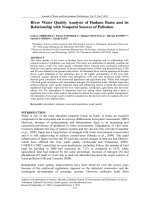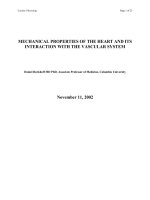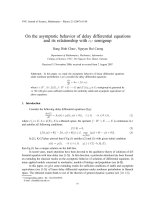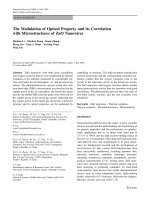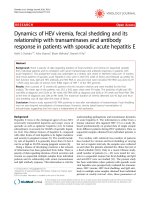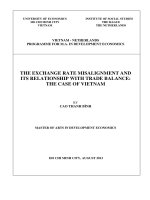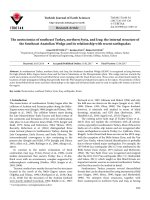research report fear of covid 19 and its relationship with working stress among lecturers at universities in danang
Bạn đang xem bản rút gọn của tài liệu. Xem và tải ngay bản đầy đủ của tài liệu tại đây (1.75 MB, 39 trang )
<span class="text_page_counter">Trang 1</span><div class="page_container" data-page="1">
<b>BTEC FPT INTERNATIONAL COLLEGE DEPARTMENT OF BUSINESS ADMINISTRATION </b>
Class: PBBA15101
<i>Da Nang, April 2022</i>
</div><span class="text_page_counter">Trang 2</span><div class="page_container" data-page="2"><b>ASSIGNMENT 2 FRONT SHEET </b>
<b>Qualification BTEC Level 5 HND Diploma in Business Unit number and </b>
<b>title <sup>Unit 11: Research Project </sup></b>
<b>Submission date </b> 20/04/2022 <b><sup>Date Received 1st </sup></b>
<b>Re-submission </b>
<b>Date Recei edv 2nd submission</b>
<b>Student Name </b> <sup>Nguyen Le Phuong </sup>
<b>Student’s signature </b>
<b>Grading grid </b>
</div><span class="text_page_counter">Trang 3</span><div class="page_container" data-page="3"><b>Summative Feedback: Resubmission Feedback:</b>
<b>Grade:Assessor Signature:Date:Internal Verifier’s Comments:</b>
<b>Signature & Date:</b>
</div><span class="text_page_counter">Trang 4</span><div class="page_container" data-page="4"><b>EXECUTIVE SUMMARY </b>
This study aims to investigate the fear of COVID-19 and its relationship with working stress among lecturers at universities in Danang. It can be seen that working stress is a major concern of businesses as well as managers. If employees are stressed at work, they will work less efficiently, decreasing business productivity. In addition, when faced with working stress, it will limit each individual's development potential and creativity. Therefore, this study will analyze working stress factors and their relationship with COVID-19.
Research results are collected by quantitative method and the research objects are lecturers of the university in Da Nang. Quantitative research is carried out by online survey method with the number of samples collected 200 samples. The study used SPSS softwaris e version 23.0 with analysis techniques including descriptive statistics, scale reliability test, exploratory analysis (EFA), and linear regression.
The study results show that Workload, Role, Efficiency, and Relationship have an impact on the Lecturers' Working Stress. In which, the Workload factor has the strongest influence. In general, studies on work stress in the education sector, especially in COVID-19, are still limited. Therefore, this study is considered a new direction for future research. The research results help university leaders understand the components of stress and the correlation between working stress and fear of COVID-19. From there, there are appropriate strategies to reduce working stress for lecturers.
<b>Keywords: Fear of COVID-19, Working Stress, Lecturers Working Stress, Workload. </b>
</div><span class="text_page_counter">Trang 5</span><div class="page_container" data-page="5"><b>ACKNOWLEDGMENTS </b>
Through studying and training at Danang BTEC FPT College, I completed my graduation thesis, majoring in Business Administration with the topic "Fear of COVID-19 and Its Relationship with Working Stress Among Lecturers at Universities in" Danang".
I would like to express my deep gratitude to Mr. Le Phuoc Cuu Long for his enthusiastic guidance and comments to help me complete this thesis. I would also like to thank the lecturers of the college, especially the lecturers of the Business Administration department, who have imparted their knowledge to me during the past three years. I wish the lecturers always have a lot of health, and success in work and life.
In the process of conducting research, mistakes will inevitably be made. I hope to receive sympathy and sincere suggestions from teachers and readers to improve the thesis.
Da Nang, April 23, 2022 Student Nguyen Le Phuong Hang
</div><span class="text_page_counter">Trang 6</span><div class="page_container" data-page="6"><b>2.4. Hypothesis & Research Model ... 6 </b>
<b>2.5. Overview of Previous Research and Contributions to The Topic ... 7 </b>
<b>4.4. Correlation Test Results ... 17 </b>
<b>4.5. Exploratory Factor Analysis ... 18 </b>
</div><span class="text_page_counter">Trang 8</span><div class="page_container" data-page="8">1
<b>1. INTRODUCTION </b>
COVID-19 is a respiratory illness caused by the SARS-CoV-2 virus and its variants. Since its discovery, COVID-19 has become a global health hazard. It causes severe effects on the health and education systems of countries around the world, Vietnam is also among them. With its rapid spread, COVID-19 has caused fear, anxiety, and mental health-related problems in the community. Fear is a negative, bewildering emotion in the face of threats. COVID-19 has become a global health hazard, it makes unprecedented changes to the fields of countries around the world, in which the health and education sectors are also worthy of attention.
The sudden change in teaching and learning from the traditional model to the online model is one of the causes of stress for lecturers. Working stress is a state of health and spirit at a time when people find it difficult and tiring to face work. In addition, working stress is anxiety and pressure from the working environment's events, such as work progress, the imbalance between work and personal life, or other external factors. Other factors such as pressure on colleagues, pressure on superiors, or they create pressure on themselves. The shift to an online teaching model has created a lot of pressure as well as difficulties for teachers. Distance time, personal income, work pressure, loss of connection with people, or anxiety about the epidemic are the pressures of the COVID-19 pandemic for each lecturer. All of this makes teachers stressed and no longer interested in starting work.
There are many research on work stress, most of the subjects covered in different professions. However, no research has yet been done in the education industry, especially in COVID-19. Therefore, this research will analyze the factors affecting the job stress of lecturers, and clarify its relationship to the fear of COVID-19. The research will show which factors have the same or opposite effects, and which factors are correlated with each other.
The research has three objectives. Firstly, identify the factors that affect working stress. Next, build a model of factors affecting working stress. Finally, describe the fear of COVID-19 and its relationship with the working stress of lecturers. Besides, the research includes five parts. Part one presents an overview of the research project. Part two presents the theoretical basis of the fear of COVID-19, stress at work, thereby building a theoretical model for the research. Part three presents the research method to test the scale, the theoretical model and the proposed hypotheses. Part four presents the method of information analysis and presents the
</div><span class="text_page_counter">Trang 9</span><div class="page_container" data-page="9"><b>2.2. Working Stress, Working Environment, Workload, Lack of Clarity in Role, Work Efficiency, Workplace Relationship, and Fear of COVID-19 </b>
<b>2.2.1. Working Stress </b>
According to Murray et al. (1996), working stress is the tolerance of work-related stressors, including work burnout or anxiety about job results. Fink (2010) also stated that working stress is a fairly common type of stress. A stressful job is seen as the result of a long process whose origin comes from the negative in an employee’s work (Schuler, 1980). Facing responsibilities that are inconsistent with employees' professional abilities, skills, and knowledge is one of the causes of working stress. An employee's degree of control over his or her job affects the employee's level of working stress.
<b>2.2.2. Working Environment </b>
According to Bartlett (2003), the working environment is understood as an enterprise's tangible and intangible conditions. Specifically, the environment includes physical conditions such as workspace, office design, and auxiliary equipment for work. Besides, the mental conditions include interaction in the workplace (colleagues, superiors, employees), company
</div><span class="text_page_counter">Trang 10</span><div class="page_container" data-page="10">3
culture, and the working spirit in the organization. Holosko (2003) believes that a good working environment creates favorable conditions for employees to maximize their capabilities and enjoy a salary commensurate with their dedication to the business.
<b>2.2.3. Workload </b>
The workload is what an individual must do (Miller, 2001). According to Morris et al. (2007), quantitative is the amount of work, it helps employees estimate that with this job, they have to do what and how much. Qualitative is the specificity of the job, meaning how difficult or easy it is. Good workload management helps employees to solve and handle work effectively, avoiding working stress (Needham, 1997).
<b>2.2.4. Lack of Clarity in Role </b>
A role represents an individual's functional position and duties in a specific situation, context, and relationship (Ganong, 2000). In a working environment, the role of an employee is played by several individuals. However, different roles are associated with different functions, responsibilities, and duties (Tepper et al., 2001). In an organization, employees need to know what their roles and responsibilities are. From there, they will know exactly what needs to be done to complete the task.
<b>2.2.5. Work Efficiency </b>
Work efficiency is the ability to complete assigned tasks quickly and accurately. High or low work efficiency often depends on many factors. In which, there are subjective factors derived from the employee's capacity and objective factors influenced by working circumstances (Yellen, 1984). Farrel (1957) states that work efficiency is a concept based on how long an individual takes to complete a task with a finite resource.
<b>2.2.6. Workplace Relationship </b>
According to Berman et al. (2002), the relationship is understood as the interaction between two (or more than two) objects or two (or more than two) groups of related objects. Building good relationships with superiors, colleagues, partners, and customers is essential for an individual's success. Ram (1991) indicates that good working relationships bring many benefits, and work becomes more enjoyable when people can work together to make changes, improvements, and innovations.
<b>2.2.7. Fear of COVID-19 </b>
Alyami et al. (2021) consider that fear is the body's response to stressful or threatening situations. It causes the individual to experience emotional and physical overload, with long-term consequences in physical, emotional, social, or spiritual aspects. The fear of
</div><span class="text_page_counter">Trang 11</span><div class="page_container" data-page="11"><b>2.3.1. Working Environment </b>
The working environment can be defined to include light, temperature, humidity, noise, and air. According to the Cincinnati National Institute for Occupational Safety and Health (Ohio), 54% of workers and 52% of human resources professionals indicate that employees feel unsafe in the working environment. This is considered an important factor that makes employees feel stressed with their current job (Elisa, 2007). A workplace with a window, or 15 minutes of sunlight per day, increases employee satisfaction. From there, it helps to increase the level of employee focus (Navia and Veitch, 2003). The working environment is one of the factors affecting the working stress of employees in the workplace (Muhammad et al., 2011). If employees perceive a good working environment, that is a workplace with adequate light, cool air, and good humidity. All of these make employees feel comfortable with the work they are doing (Srisvastava, 2008). Therefore, hypothesis 1 is put forward as follows:
H1: The worse the working environment, the more stressful at work.
<b>2.3.2. Workload </b>
When the complexity of the job increases, employees will use their brains to control and adjust the workload accordingly. This means that they will arrange their work to see what should be done first and what should be done later (Muhammad, 2012). Several recent studies have shown the consequences of employee stress when the workload is too much, or the employee has to work too much. According to Wilkes et al. (1998), work overload and time constraints to perform work are two factors that have a strong impact on employee work stress. Workload stress can be defined as the reluctance to perform a job in the workplace. A constant feeling of stress accompanies psychological and physiological manifestations and behaviors and symptoms in general. Hendy et al. (2001) have shown that time pressure is the main cause of stress when the workload is too much. Time constraints are also used to determine performance and evaluate employee workload performance. Hypothesis 2 is put forward:
H2: The greater the workload, the greater stressful at work.
<b>2.3.3. Lack of Clarity in Role </b>
</div><span class="text_page_counter">Trang 12</span><div class="page_container" data-page="12">5
The lack of clarity in the employee's role is another aspect that affects job stress. Sims (2001) concluded that it is not clear in the employee's role that there is a positive correlation with variables such as Level of Work, Performance, Working Stress, and Propensity to UnderWork. In addition, the lack of clarity in an employee's role means a lack of accurate information about their responsibilities and job expectations. It is important in fulfilling the employee's role (Kahn et al., 1964). Breaugh and Colihan (1994) assert that employees have a sense of ambiguity in their work in an ambiguous role. At the same time, the two authors also raise the point that ambiguity in employees' work mainly focuses on three different aspects: Working Methods, Planning Criteria, and Working Performance. Not only that, Muchinsky (1997) has shown that the lack of clarity about the employee's job role leads to negative outcomes such as a decrease in the employee's self-confidence, creating a sense of hopelessness, or employees feeling anxious all the time. If this situation persists, the employee may fall into a negative state, thereby leading to stress at work. Therefore, hypothesis 3 is put forward:
H3: The more unclear the role, the more stressful at work.
<b>2.3.4. Working Efficiency </b>
According to Selye (1956), stress is an indispensable part of life, however, stress does not always hurt an individual or an employee on the employee's job. Moderate stress or pressure can improve an individual's work efficiency. Scott (1966) asserted that when personal stimulation increases work efficiency, it leads to increased work stress. When the stimulus to increase work efficiency exceeds the limit, work stress, and work efficiency decrease together. Besides, Srivastava and Krishana (1991) provided evidence that an inverted U-shaped relationship always exists between work efficiency and work stress in today's world. Furthermore, Selye (1975) also hypothesized an inverted U-shaped relationship between work efficiency and work stress He argues that performance is optimal when the moderate stimulus to increase efficiency. It means we should stimulate at the optimal point. On the contrary, when the stimulation level is too high or too low, the work efficiency will decrease. Therefore, hypothesis 4 is developed as follows:
H4: The greater the working efficiency, the greater stressful at work.
<b>2.3.5. Workplace Relationship </b>
For most jobs, each employee spends more time with their colleagues than with their superiors. Therefore, like relationships with superiors, relationships with colleagues also affect work stress. Similar to the relationship with superiors, employees need support, help from colleagues when needed, and find comfort and friendliness when working with colleagues
</div>